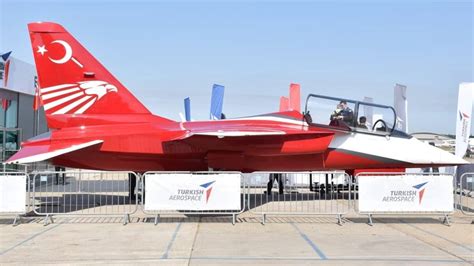Welcome to a fascinating journey through the world of Turkish aerospace achievements! Turkey’s foray into the skies is not just a tale of ambition and ingenuity, but also a testament to its commitment to carving out a place among the stars. In this blog post, we will delve into the rich History of Turkish Aerospace Industry, unfolding its evolution and pivotal moments that have shaped its present state. We’ll take a closer look at the Development of Turkish Fighter Jets, marveling at the technological prowess and strategic prowess that fuel these fierce birds of prey. Understanding the Role of Turkish Aerospace Products in National Defense will reveal the depth of their significance in safeguarding sovereignty. We’ll also explore the heights of innovation with Turkish Satellite Technologies and Applications, showcasing Turkey’s vision for the future. Finally, we’ll analyze the Turkish Aerospace Industry’s Global Competitiveness, highlighting the country’s emerging status on the international stage. Strap in as we embark on a voyage through the Turkish skies where innovation meets ambition.
Titles
History of Turkish Aerospace Industry
The history of the Turkish aerospace industry dates back to the early 20th century, when the establishment of aviation schools and initial aircraft workshops marked the beginning of a long journey toward self-sufficiency in aerospace technologies. The industry witnessed a significant evolution during the subsequent decades, spurred by national aspirations and strategic necessities which mandated the development of domestic capabilities in aircraft manufacturing, maintenance, and modernization.
In the post-World War II era, Turkey embarked on a series of collaborations and technology transfer agreements, laying the groundwork for the burgeoning Turkish aerospace sector. Notable milestones were achieved when Turkey began manufacturing under license and expanding its indigenous research and development activities. The establishment of key institutions and infrastructures signaled the country’s earnest commitment to advancing its footprint within the global aerospace community.
The late 20th century saw the flourish of the Turkish aerospace industry, with the emergence of significant players in the market, the introduction of sophisticated military and civil aerospace projects, and an increased focus on exporting aerospace products and services. This period was characterized by an invigorated drive towards indigenization and innovation, which laid the essential foundation for the current ambitions of designing and manufacturing advanced aerospace systems wholly within Turkey.
Entering the 21st century, the Turkish aerospace industry has continued to mature, marked by ambitious projects such as the development of national fighter jets and the launching of indigenous satellites. It has become a pivotal sector that not only ensures national security and contributes to technological progress but also boosts the country’s economic growth and global competitiveness through strategic partnerships and increasing exports.
Development of Turkish Fighter Jets
The development of Turkish fighter jets has experienced a significant evolution over the past decades, shaping Turkey’s strategic military capabilities and showcasing its growing expertise within the aerospace industry. The progression from reliance on imported designs to the cultivation of indigenous projects underscores a commitment to self-reliance and technological innovation. In particular, the conception and ongoing development of the TAI TF-X, a fifth-generation jet fighter that is poised to become the backbone of the Turkish Air Force, epitomizes Turkey’s ambitious stride towards establishing itself as a noteworthy player in the arena of advanced aviation technologies.
Focusing on the modern era, one cannot overlook the pivotal role of the Peace Eagle Program, which was key in advancing Turkish aerospace engineering, resulting in the production of the F-16 Fighting Falcons under license. These versatile aircraft have been modified and enhanced by Turkish engineers to meet the unique demands of the Turkish Air Force, thus laying the groundwork for more sophisticated, homegrown fighter jet designs. As a testament to this prowess, the TAI Hürjet project, aimed at designing and building an advanced jet trainer and light attack aircraft, further accentuates the nation’s growing capability and expertise in the domain of fighter jet production.
The collaboration between Turkish Aerospace Industries (TAI) and an array of international aerospace companies has infused the development of Turkish fighter jets with a wealth of knowledge and experience. Such synergistic partnerships have facilitated technology transfer agreements, allowing Turkey to assimilate cutting-edge technologies and to propel its indigenous projects forward. Through these strategic alliances, Turkey is notably enhancing its intellectual capital and laying the foundation for a robust, self-sufficient aerospace sector that can stand toe-to-toe with global aerospace giants.
Yet, it is the ambitious vision and substantial investments in research and development (R&D) that are the true harbingers of the extensive progress within the Turkish fighter jet development initiatives. The Turkish government and private sector’s commitment to R&D has engendered a fertile environment for innovation, enabling the country to not only meet its internal security demands but also to strive for a significant presence in the global market. With every milestone in the development of indigenous fighter jets, Turkey reinforces its status as a rising power in aerospace technology and defense.
Role of Turkish Aerospace Products in National Defense
The Role of Turkish Aerospace Products in National Defense has been decisively transformative in recent years, marking a significant shift towards domestic development and self-sufficiency. In the face of complex geopolitical dynamics and evolving security challenges, Turkey has strengthened its defense capabilities through an extensive array of aerospace technologies and products, which not only bolster the nation’s defensive posture but also reflect a strategic intent to lessen dependence on foreign suppliers and to assert its position in the region.
Central to this endeavor has been the advancement of the Turkish defense industry’s aeronautical division, which has yielded state-of-the-art unmanned aerial vehicles (UAVs), manned aircraft, helicopters, and cutting-edge missile systems. These systems provide the Turkish Armed Forces with enhanced intelligence, surveillance, and reconnaissance (ISR) capabilities, precision strike options, and a robust defense matrix against diverse threats. Significantly, the Turkish defense strategy stresses the utility of indigenous aerospace products to ensure a swift and autonomous response to national security incidents, thereby reinforcing the overall deterrent effect.
Furthermore, the strategic insertion of Turkish aerospace products into the national defense portfolio has been pivotal in fostering an innovative defense ecosystem. Through collaborations between the government, research institutions, and burgeoning private sector companies, a conducive environment for technological advancement has been cultivated, which, in turn, has accelerated the development of sophisticated aerospace systems. These initiatives underscore the importance placed on owning the complete lifecycle – from design and development to production and maintenance – thereby fortifying the national defense structure with resilient and reliable aerospace capabilities.
In pursuit of expanding its strategic autonomy, Turkey has also been keen to integrate advanced technologies such as artificial intelligence, satellite communications, and cyber defense mechanisms into its aerospace products. This integration not only amplifies the potency of these products within the spectrum of national defense but also propels the Turkish Aerospace Industry into a prominent position on the global stage, where its products are increasingly recognized for their quality, innovation, and operational effectiveness. Hence, the role of Turkish aerospace products in national defense has become emblematic of the country’s quest for technological sovereignty and its emergence as a formidable player in the defense sector.
Turkish Satellite Technologies and Applications
The Turkish satellite technologies have been accelerating at an impressive pace, leading to a range of applications that have significant implications for both civilian and military domains. As a pivotal element in the nation’s strategic tech expansion, these advancements showcase not merely a leap in capabilities but also a commitment to leveraging space assets for comprehensive national development. Through the indigenization and innovation of satellite technology, Turkey has started employing advanced earth observation satellites, communication satellites, and satellite launch systems, underscoring a growing independence in space technology.
Turkey’s prowess in satellite technology came to the forefront with the commissioning of satellites such as Türksat and Göktürk, which serve as linchpins for the national defense and civilian sectors, much like a double-edged sword that sharpens the country’s edge on both fronts. The deployment of such satellites has not only bolstered the telecommunication infrastructure but has also provided invaluable data for urban planning, agricultural monitoring, and disaster management, enhancing the societal resilience against calamities and aiding in prompt strategic response.
With a keen eye on the future, the Turkish aerospace industry continues to rapid-fire breakthroughs, especially in the arena of satellite development and application. The integration of satellite-generated data into the day-to-day functions of government and private sectors is reflective of a mature ecosystem that nurtures innovation, strategic alliances, and the growth of knowledge capital within the nation. The Turkish space agenda, bristling with projects, promises greater autonomy in satellite manufacturing, an ambitious timeline for more sophisticated ventures, and an evolution of capabilities that could redefine Turkey’s standing on the global space exploration stage.
The global competitiveness of the Turkish aerospace industry is testament to its strategic vision. As Turkey scales new heights with satellite technologies and applications, the focus on optimizing localization, boosting economic growth via space technology, and pushing the bounds of what can be achieved in orbit spills into the international recognition of the country’s space pursuits. Moving forward, the ability to design, deploy, and operate cutting-edge satellites not only paves the way for Turkey’s inscription among the cosmos-exploring nations but also propels the economy into a future where space becomes the final frontier for innovation, security, and exploration.
Turkish Aerospace Industry’s Global Competitiveness
In the realm of global aerospace, the Turkish Aerospace Industry has made significant strides, propelling the nation to the forefront of technological advancement and industrial prowess. With a focus on innovation and self-reliance, Turkey has been at the helm of creating cutting-edge solutions, which not only serve its national interests but also demonstrate the capability to compete in the international market. The country has meticulously invested in research and development (R&D), leading to a rise in export of its aerospace products, thus marking its presence on the global stage as a formidable player.
As a testament to its growing influence, the Turkish Aerospace Industry has been actively engaging in collaborations with world-leading aerospace corporations, fostering a climate of mutual growth and technological exchange. This, in turn, has led to an increase in the quality and competitiveness of Turkish aerospace products, allowing the nation to bid for and secure significant contracts on a worldwide scale. The thrust towards enhancing quality standards in line with international norms is a strategic move that has amplified the industry’s global appeal and trustworthiness.
The ambition to elevate its status in the sphere of global aerospace is further evident in the monumental efforts undertaken in the development of sophisticated Turkish fighter jets. With projects such as the TF-X, Turkey is not just aiming to meet its own defense needs but is also setting its sights on becoming a leading exporter of these advanced combat aircraft. This endeavor has positioned Turkey as a budding powerhouse in the defense sector, ready to supply high-tech aerospace solutions that cater to the demands of the 21st century.
Moreover, the efficacy of the Turkish Aerospace Industry in the global arena is reinforced by its forays into satellite technologies and various other aerospace applications. Turkey’s drive to enhance its capabilities in space exploration and satellite communication is yet another indicator of its ambition to establish a firm grip on the wider aspects of the aerospace sector. The future looks promising as the industry continues to make strides, pushing the boundaries of innovation and securing its place as a globally competitive and influential aerospace player.






